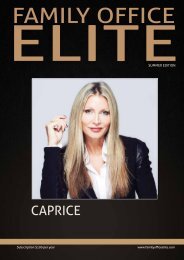Family Office Elite Spring_16
Family Office Elite Magazine, the wealthiest audience in the world. Family Office Elite Magazine is a very high class bespoke publication and a porthole to the ultra-wealthy family offices and UHNWI sectors. The magazine includes editorials from recent events and experts from the ultra-wealthy Family Office community.
Family Office Elite Magazine, the wealthiest audience in the world.
Family Office Elite Magazine is a very high class bespoke publication and a porthole to the ultra-wealthy family offices and UHNWI sectors. The magazine includes editorials from recent events and experts from the ultra-wealthy Family Office community.
You also want an ePaper? Increase the reach of your titles
YUMPU automatically turns print PDFs into web optimized ePapers that Google loves.
SOUTH KOREA<br />
EXPLORING HNW AND UHNW POTENTIALRG<br />
Over the years, it has been very difficult to map the<br />
true wealth that has been generated in South Korea. In<br />
addition to a general reluctance of the High Net Worth<br />
(HNW) & Ultra High Net Worth (UHNW) families to go<br />
public about their wealth, there is a unique Korean<br />
wealth hierarchy which has no other similar structure<br />
in the world. In comparison with other Asian countries<br />
like China and Indonesia, the coverage and knowledge<br />
of the super wealthy in Korea have been kept out of the<br />
spotlight to a certain extent. However if we look closer<br />
into its UHNW segment, it becomes a true revelation<br />
for the rest of the world, and there is huge potential<br />
for the wealth management industry and family office<br />
businesses as a whole, explains Rakesh Naker, Head of<br />
International Business at Machlin-Oracle (part of Oracle<br />
Capital Group).<br />
<strong>Family</strong> conglomerates in Korea are called Chaebols, and<br />
they came into existence in the 1960’s when President<br />
Park Chung Hee came to power and helped South Korea<br />
start its rapid rise to becoming a major industrialised<br />
nation. The Chaebols wealth rose rapidly during the<br />
1980’s and 1990’s, but in turn, this has led to the gap<br />
between the rich and poor widening, especially since<br />
the Asian financial crisis in the late 1990’s. To put this<br />
into perspective, the 2015 OECD report states that the<br />
top 20% of the population earned nearly six times as<br />
much as the bottom 20% of the population.<br />
This is primarily because the Chaebols have flourished<br />
to make Korea the economic powerhouse that it is<br />
today. This is further evidenced by the fact that there<br />
are approximately 20 billionaire families in South<br />
Korea, and nearly 100 families with assets greater than<br />
$250m, out of a population of nearly 50m people.<br />
Furthermore, the richest family in Asia in 2015,<br />
according to Forbes, was a South Korean family, with<br />
a combined wealth of over $26bn. This family’s net<br />
revenues in 2014 amounted to nearly 22% of Korea’s<br />
GDP alone. In turn, the number of Ultra High Net Worth<br />
(UHNW) people (classed as those with wealth greater<br />
By Rakesh Naker<br />
Head of International Business at Machlin-Oracle<br />
than US$50m in net assets) has grown to approximately<br />
1,800, as of 2015. However when you compare this to<br />
the rest of the Asia-Pacific region, which has just under<br />
<strong>16</strong>,000 UHNW families, South Korea with around 11%<br />
of the Asia-Pacific wealth, still has a way to go.<br />
Traditionally when wealth is generated, it is put back<br />
into the family’s operating businesses, which in turn has<br />
helped to create the conglomerates that we are familiar<br />
with today. This is how the Chaebols have grown over<br />
the years, and this is a normal, traditional practice but<br />
in turn, this opens up a door of opportunity.<br />
Due to the tradition of recycling profits back into the<br />
operating businesses, these UHNW families are now<br />
seeking advice and guidance on how to segregate<br />
their wealth out of the business and put it aside for “a<br />
rainy day”. Furthermore, the concept of a <strong>Family</strong> <strong>Office</strong><br />
is still fairly new in Korea and Asia as a whole. Where<br />
some <strong>Family</strong> <strong>Office</strong>s exist, the structure is more likely<br />
to be dominated by the family members, which is in<br />
contrast to the normal operating structure seen in the<br />
Western world. This, in turn, means that the concept<br />
of segregation can be lost as independent advisors<br />
are not engaged to the fullest extent. However, this<br />
trend towards a more professional structure is starting<br />
to change in conjunction with generational change,<br />
where the existing <strong>Family</strong> <strong>Office</strong>s are now looking<br />
79<br />
FAMILY OFFICE ELITE MAGAZINE



